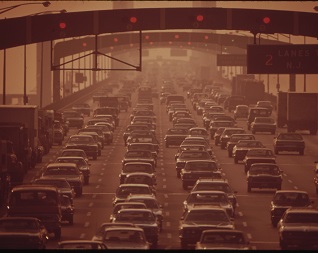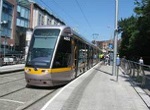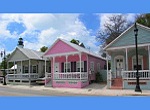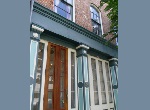Effects of Urban Sprawl: Costs, Health, Environment
Last Updated: November 20, 2023
Effects of urban sprawl can be devastating or subtle in and around large, medium-sized, and small cities, and even small towns. On this page we will be describing some of the negative consequences or results of sprawl, by which we mean the spreading out of the footprint of a city or town beyond what would be necessary to accommodate population increase.
 Whitman Bridge from Philadelphia Area to New Jersey, Mid-1970s. U.S. National Archives, Dick Swanson, Photographer.
Whitman Bridge from Philadelphia Area to New Jersey, Mid-1970s. U.S. National Archives, Dick Swanson, Photographer.Growth and sprawl are different, as we hope you'll come to appreciate. Do not be offended if we call it an urban or suburban issue and you are in a small town. We are simply relying on the terms most commonly used.
We will help you identify sprawl consequences for your metropolitan or micropolitan area. (A "micropolitan" area is one with a core city of at least 10,000 people, but fewer than 50,000. So if you live a mile outside a town of 12,000 folks, you live in a micropolitan area.)
Since we confine our definition of sprawl to instances in which increases in urban land use exceed population demand, a metro area can grow considerably through infill of the spaces between developed sites, without sprawling a bit.
The High Costs of Automobile-Dependent Transportation
At the sprawling edge of the city, and further in if the sprawl tendency has been ongoing for the last 50 or 60 years, traffic seems to become ever more congested.
Partly this occurs because of family patterns, where children are frequently delivered to school by automobile and where two adults now are working. Parents often decide to enroll children in every lesson and after-school activity that seems remotely feasible, so those trips add to the traffic also. While some of these patterns have been disrupted by the pandemic, with more people working at home and other families being forced to depend on only one wager-earner, it remains to be seen whether these are permanent disruptions or simply blips on the chart of the ongoing effects of urban sprawl.
But beyond household patterns, the fact is that there are few true town centers where multiple errands can be accomplished during one trip. The downtowns of large cities usually don't afford convenient grocery shopping and the dry cleaner adjacent to the major department store. In fact, "major department stores" are mostly a nostalgic idea instead of a reality in all but the largest cities.
As big box stores (large discount stores) have become the store of choice for many people, they may be able to take care of a few needs nearby, but adjoining restaurants and services tend to be set up for customers to drive to them, rather than walk.
If you don't drive, you're in for a tough time in most areas. Each metropolitan area offers a few pedestrian-friendly walkable communities where you can find shops, restaurants, banks, and some services, but often keeping a grocery store in these locations is a hard sell. As the pandemic hit small merchants, keeping the storefronts full in even very attractive areas has become difficult.
Many people experience ugliness in the road dominance, incessant traffic, and excessive accommodation for automobiles through protruding garages and huge mostly vacant parking lots. It's a scene that mostly auto dealers and road building contractors love. But it's one of the effects of urban sprawl.
The cost in auto accidents is very high too. It's not unusual for fatal accidents to occur at the intersection of two 40 mile per hour arterial roads. In turn the accident rates cause higher automobile insurance costs, another cost attributable to the effects of urban sprawl.
With more driving comes more air pollution. While the suburbs don't necessarily experience an obnoxious, visible amount of pollution, they certainly contribute when their residents commute to closer to the center of the city to work.
It's also time that we clearly associate our driving habits with climate change. Even if you don't quite believe that every thunderstorm, snow storm, or drought is due to climate change, you should be quite concerned about the possibility of the governmental, economic, and social costs of having to relocate massive numbers of people due to rise in sea level as polar ice caps melt due at least in part to greenhouse gas emissions. About a fifth of U.S. greenhouse gas emissions come from our cars and trucks, and of course sprawl really aggravates our vehicle miles traveled per household. (For more on this aspect of the sprawl discussion, see our climate change planning page.)
So far we have been talking about intangible negatives of a sprawling environment, which each person will value differently. However, some of the most important effects of urban sprawl are directly related to monetary costs. Every time gasoline prices spike due to the whims of petroleum producers or supply chain problems, some households feel the pinch.
A sprawling pattern means that the road transportation system has to be lengthy, miles driven and delays due to traffic congestion are high, and transit becomes cost-ineffective because overall density is low. All of these add up to higher financial costs, either at the household level (for example, gasoline and automobile purchase and maintenance costs), or at the governmental level (for road building and repair, or for inefficient transit systems). Of course governmental costs then equate to taxpayer costs.
Disinvestment Downtown and in the Inner Suburbs
Most cities look like an urban doughnut when healthy activity is mapped. The hole in the middle where downtown tries to survive has come to pass because one by one, businesses and institutions moved to the suburbs. The disinvestment in most cities has now spread far beyond the urban core, however.
Inner suburbs, depending on their age, may now be showing the effects of urban sprawl. The small houses built on the promise of veterans' financing after World War II are now painfully obsolete, as households and even single people crave large closets, two-car (or more) garages, and a guest bedroom and bathroom, not to mention offices, home gyms, and the like.
Due to sprawl, small houses, obsolete architectural types, and older housing have a hard time competing in the marketplace. Who wants to worry about major renovation and room additions if you can find a brand new house in the far suburbs for about the same price?
We're not just being sentimental architects when we talk about
this. The disinvestment pattern has tremendous implications for the
finances of the public sector. That translates into your tax rate!
When demand for the older houses declines, the municipality cannot abandon the street. Not only does the street need resurfacing, but about now, those 50-year-old sidewalks are looking pretty decrepit, if you're so lucky as to have any sidewalks. As for your street lighting, sometimes it works, and sometimes it doesn't.
The developer at the edge of the urbanized area, developing on greenfields (areas that have not been developed for urban use previously), has to install new streets and new sewer and electrical and maybe broadband structure.
Never mind that these utilities already are available closer to the center of the city in a neighborhood whose housing stock has become slightly dated. It's just easier to develop new housing. And buyers prefer it, at least if they have few other choices that fit their lifestyle.
The inefficiency of these effects of urban sprawl to the public sector--and therefore to you, the taxpayers--tends to be masked because the municipality building the new infrastructure, or taking on the future responsibility for infrastructure maintenance, may be a suburban government, not that of the central city.
If everyone in a metropolitan area could look at their public sector investment as a whole, the effects of urban sprawl would come to a screeching halt as we realized how much extra money we're spending in most cities on infrastructure that is being duplicated on the edge of the city.
Lack of Choice of Housing Types
Because the effects of urban sprawl include duplicating more and more the most popular floor plan from the last development, we are left with fewer choices ultimately. One of the effects of urban sprawl that I find really distasteful is the homogenous nature of the housing stock we're leaving for our children.
Of course lack of housing choice can be alleviated in suburbs more than 30 or so years old. The process of housing renovation in the urban core and older suburbs leads necessarily to creative problem-solving as developers attempt to meet current market demands in a multiplicity of ways.
The housing shells themselves provide more variety than today's developments, which tend toward similarity and mass production. Renovation strategies that can provide the housing features today's buyers want are quite diverse.
I've seen two car garages that are tandem style where one car parks in front of the other. Entire bedrooms are turned into walk-in closets. Walls are eliminated to provide open flow between rooms and rescue the kitchen from its isolation. Additions to the back, front, side, and top of the home are made.
Small groups of homes on a cul de sac are formed into a homeowners association and instantly upgraded to "villas."
Former industrial and commercial buildings downtown find new life as unique residences. Smaller places of worship in semi-rural areas become housing, as do former corner groceries in cities. While adaptive reuse projects are fun to work on, they are more time-consuming for developers and more risky for financing because they are one-of-a-kind projects.
But developers will only work on these projects if they can be distracted from the repetitive and predictable profits resulting from the effects of urban sprawl.
Concentration of Poverty Is One of the Major Effects of Urban Sprawl
Recently I made a presentation to social workers, and I asked them if they considered the geographical concentration of poverty in a few areas to be a problem. I thought they might say that no, poor people should be able to live where they've always lived, or where they are comfortable because others are in a similar predicament.
However, I learned that the social work community fully appreciates that the concentration of poverty means the concentration of problems, a lack of positive role models and the social networks that support obtaining employment, poor public schools for those who can least compensate at home, and the withdrawal from pockets of poverty of well-capitalized businesses that provide jobs, goods, and services.
The effects of urban sprawl increase as the physical distance between the haves and the have-nots becomes greater and greater. Probably that's correlated to social distance. Social isolation for a group of folks in poverty not only robs them of positive role models, but also feeds the sense of hopelessness.
You'd be a pessimist too if everyone you knew and interacted with on a daily basis was unemployed or underemployed. Such desperation can lead to crime and anti-social activities such as turning to drug dealing to make a living.
Another big point is that population sprawl leads to job sprawl. Businesses want to locate in a place that is convenient for the workforce and the executives.
As the workforce lives further and further out in the suburbs, a business has an all too convenient excuse for leaving its historic roots in or near the city center. And when jobs are further away from the concentrations of poverty, a reliable work commute every day is even more difficult.
Mobilizing the social justice community to understand the effects of urban sprawl better is critical to forming the right coalitions to fight sprawl.
Sprawl and Health
Increasingly people want to say that the lack of exercise, and therefore poor health, are effects of urban sprawl. I'm not sure I buy that completely, as I need forms of exercise beside walking.
However, the point is that we can't use walking as transportation in most of sprawling suburbia. So we ride, grabbing some fast food between errands. Beyond not getting any exercise, we gain excess calories and add to the total air pollution floating around.
Certainly when we look at the effects of urban sprawl on children, it may be more defensible to talk about health. Children once obtained their exercise naturally, walking and biking everywhere, and playing actively in the outdoors.
Since in the edges of most cities, the abundant open space is fenced into back yards, the children don't have much of an opportunity to interact with nature's streams. The woods often were scrapped when the Normandy Woods subdivision was constructed.
Since we started the website, information on this topic has mushroomed. Check out our page on effects of sprawl on public health.
Increased Costs for Communities and Taxpayers
The low density residential patterns typically appearing as one of the effects of urban sprawl increase the demand for road building, and the need for spending money on new schools, public services, utilities, waste disposal, and water and sewer infrastructure follow.
Police, fire, and emergency medical services must be provided immediately, but the demand for recreation programs and centers won't be far behind. Even if developers are billed for the obvious additions to roads and storm sewers, the effects of urban sprawl on public services are significant.
Remember that even if the developer pays for the streets in the new development, those new residents must drive to work, shop, and recreate. These trips will add congestion to roads that already are at capacity, in some instances. The intervening streets will require a serious rebuild sooner than had the sprawl not occurred.
Many people suppose that the property taxes generated by the new development offset these costs, but only rarely does residential development contribute as much to municipal coffers as it removes. Certainly in the case of new capital expenditures and public services, the public sector funding will not keep up.
In fact many economists assign a negative value to the impact of new residents on public services in the central city, because infrastructure--both the service infrastructure and physical one--already is in place. A new customer simply lightens the load for others.
Many visitors to this site who are here to learn about urban neighborhood revitalization actually see an increase in their property values when new households moves in. But those of you on the very edge of urbanization find new households add a distinct financial burden as one of the effects of urban sprawl.
The more rural the area that is being provided with urbanized services, the more severe the tax burden becomes.
Mingling the urban area with the rural fringe also causes other costs that people don't think about. For instance, wildfires at the edge of the suburbs are becoming a problem almost everywhere. Besides private property damage and misery--and therefore eventually rising homeowners insurance costs eventually--the public cost of firefighting is becoming a major municipal burden in these almost no-win situations. We think wildfire prevention requires rethinking development patterns.
Sometimes when I give an anti-sprawl talk, people enter the room thinking this is some sort of liberal idea. But if I have time to show the actual researched cost numbers, every single conservative in the room leaves extremely motivated to fight sprawl. This is a topic where real agreement is possible if we think rationally about the advantages and disadvantages of particular development patterns.
Loss of Rural Heritage and Open Space
Depending on your geography, you might be losing something important when you allow the effects of urban sprawl to continue unabated. The rural heritage is valued from a sociological point of view in many places in the world.
As another aside, it's really important to notice that loss of agricultural land means loss of local food production in most urban areas.
Rural living is a particular culture that not only provides food--and corn for ethanol and soybeans for almost everything--but also a particular way of life that many families on the fringe of your urban area may cherish.
If there's some nostalgia for the rural way in your area, count the loss of that hard to measure public good as you enumerate the effects of urban sprawl. Certainly isolated instances of sprawl, such as the small subdivisions that tend to intrude on rural land first, are damaging to the rural landscape.
As we who have worked with code enforcement have learned, it also leads to strange conflicts, such as complaints that the roosters are crowing too early in the morning, the goat got out and damaged someone's lawn ornament, or the horses are running and making a lot of noise. So there's even a public sector code enforcement cost to a rural-exurban interface.
If your geography means that your hinterland (it's a geography term and not meant to be a put-down) is more of a forest than a series of farms, you also are suffering a loss that shouldn't be taken lightly if the effects of urban sprawl gradually eat away at the forest line. Walking in the forest or mountains is a restorative pleasure that is precious to a certain part of your population.
The ecological value of your open space or agricultural land is important too. It absorbs your air pollution and gives Mother Earth a break from your various kinds of chemical pollution. In many instances the rural land is critical to your groundwater restoration.
With help from your state government or a private conservation organization, you can evaluate exactly what the effects of urban sprawl on your surrounding rural areas are likely to be.
Summary of the Major Effects of Urban Sprawl
Sprawl results in:
- Decreased livability, due to lack of walkability or bikeability and increased traffic
- Lack of maintenance and renewal investments in downtown areas, urban neighborhoods, and the inner ring of suburbs around a central city, resulting in gradual declines of areas where street and utility infrastructure already exists
- Loss of variety in housing choices as mass-produced housing predominates
- Concentration of community poverty leading to an even more bleak future and desperate choices
- Obstacles to spontaneous exercise opportunities through walking
- Increased costs for communities and taxpayers for public infrastructure, utilities, and services, including fighting wildfires
- Loss of the sociological and ecological benefits of rural heritage, local food production, and open space
If you're ready to adopt fighting sprawl as part of your agenda, head over to learn about solutions.
Read About Sprawl Remedies
- Making and Keeping a Good Community >
- Community Challenges, Common Topics & Concepts >
- Urban Sprawl > Effects of Urban Sprawl on Your Neighborhood
Join GOOD COMMUNITY PLUS, which provides you monthly with short features or tips about timely topics for neighborhoods, towns and cities, community organizations, and rural or small town environments. Unsubscribe any time. Give it a try.




